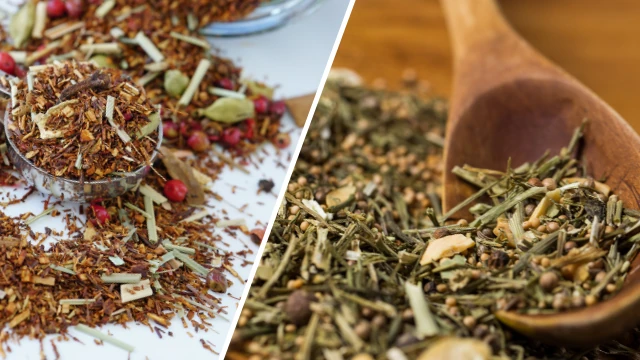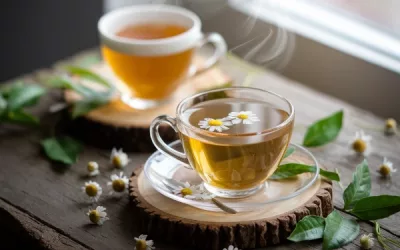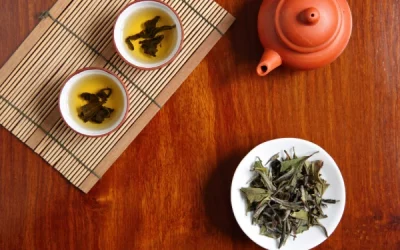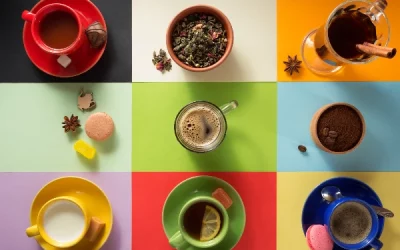Did you know that tea is one of the most consumed beverages globally, second only to water? As a health-conscious individual, choosing the right tea can significantly boost your wellness journey, especially if you’re managing a chronic health condition. In this article, we’ll dive into a head-to-head comparison of green tea and rooibos, exploring their unique health benefits, antioxidant properties, and suitability for caffeine-sensitive individuals. By the end, you’ll have a clear understanding of which tea might better serve your health needs.
Table of Content
- Key differences: Green Tea vs Rooibos Tea
- Is rooibos tea a better option for individuals with caffeine sensitivities?
- How do the flavours of rooibos and green tea differ?
- Which tea is better for overall health: rooibos or green tea?
- What factors should one consider when choosing between rooibos and green tea?
- Conclusion
Key differences: Green Tea vs Rooibos Tea
When you’re staring at the tea aisle, wondering whether to go for green tea or rooibos tea, it helps to know what sets these two apart. Both have their unique traits, flavours, and origins, making each one special in its own way. Let’s break it down so you can decide which one suits your taste and needs better. The following are key differences of green tea and rooibos tea:
1. Origin:
- Green Tea: Comes from the Camellia sinensis plant. It’s primarily grown in countries like China and Japan, where tea drinking is a cultural ritual.
- Rooibos Tea: Made from the Aspalathus linearis plant, native to South Africa. Also known as red bush tea, it’s often a staple in South African households.
2. Caffeine Content:
- Green Tea: Contains a moderate amount of caffeine. It’s good if you need a bit of a pick-me-up without the jitters of coffee.
- Rooibos Tea: Naturally caffeine-free, making it a great option for those looking to avoid caffeine altogether, including children or those sensitive to caffeine.
3. Flavour Profile:
- Green Tea: Tends to be light and grassy with a slightly bitter taste. Some people describe it as having a vegetal or herbaceous flavour.
- Rooibos Tea: Has a sweeter, more mellow taste with hints of nuttiness and earthiness. It lacks the bitterness, making it a soothing option for evening relaxation.
4. Processing Method:
- Green Tea: The leaves are steamed or pan-fried shortly after harvesting to prevent oxidation, which helps maintain their green colour and fresh flavour.
- Rooibos Tea: The leaves are fermented (oxidised), which gives them a reddish-brown colour and a rich, sweet flavour.
5. Appearance:
- Green Tea: Typically light green to yellow when brewed. The leaves retain a green colour.
- Rooibos Tea: Brews into a deep red-brown colour, with finely chopped leaves that look more like needles.
6. Nutritional Content:
- Green Tea: Rich in catechins, a type of antioxidant that may contribute to its reputation for promoting health. Contains vitamins such as B2 (riboflavin) and folic acid.
- Rooibos Tea: Contains antioxidants too, but in different forms, like aspalathin and nothofagin. It’s also rich in minerals like iron, calcium, and magnesium.
7. Traditional Uses:
- Green Tea: Often used in traditional Chinese and Japanese tea ceremonies. It’s also used in various culinary dishes like green tea ice cream.
- Rooibos Tea: Traditionally used by the Khoisan people of South Africa for its soothing and calming effects. Today, it’s popular in lattes and even skincare products.
Below is a table that outlines the key differences between green tea and rooibos tea. The table provides a clear comparison based on various attributes such as origin, caffeine content, flavour, and more.
| Attribute | Green Tea | Rooibos Tea |
|---|---|---|
| Origin | Camellia sinensis plant, mainly China, Japan | Aspalathus linearis, native to South Africa |
| Caffeine Content | Moderate | Caffeine-free |
| Flavour Profile | Light, grassy, slightly bitter | Sweet, mellow, nutty |
| Processing Method | Steamed or pan-fried to prevent oxidation | Fermented (oxidised) |
| Appearance | Light green to yellow brew, green leaves | Deep red-brown brew, needle-like leaves |
| Nutritional Content | Rich in catechins, vitamin B2, folic acid | Contains aspalathin, iron, calcium, magnesium |
| Traditional Uses | Tea ceremonies, culinary dishes | Traditional Khoisan drink, used in lattes and skincare |
Structure of the Table
- Columns:
- Attribute: Lists the different characteristics being compared.
- Green Tea: Details related to green tea for each attribute.
- Rooibos Tea: Corresponding details for rooibos tea.
- Rows:
- The table includes seven rows, each representing a distinct attribute: Origin, Caffeine Content, Flavour Profile, Processing Method, Appearance, Nutritional Content, and Traditional Uses.
Whether you prefer the grassy, slightly bitter taste of green tea or the sweet, earthy notes of rooibos, each tea offers its own unique experience. Green tea is great for those looking for a mild caffeine boost and a fresh flavour, while rooibos provides a caffeine-free alternative with a soothing taste, making it perfect for winding down.

Is rooibos tea a better option for individuals with caffeine sensitivities?
If you’ve ever found yourself jittery and wide-eyed at 3 a.m., thanks to a late-night cuppa, you might want to listen up. You’re probably wondering if rooibos tea is the magical solution for your caffeine sensitivities. Spoiler alert: it just might be. So, let’s break this down and see how it stacks up against the ever-popular green tea.
Rooibos tea has a secret weapon up its sleeve – it’s naturally caffeine-free. Yes, you heard that right, zero zilch, nada! Meanwhile, green tea, as refreshing as it is, does contain caffeine, albeit less than coffee or black tea. But for some, even a small caffeine jolt can send their system into overdrive. So, when your body treats caffeine like an unwanted house guest, settling in with a cup of caffeine-free rooibos becomes much more appealing. Plus, Rooibos gives you many of the same health perks without the late-night hyperactivity.
What are the effects of caffeine on health?
Let’s have a quick chat about caffeine. Imagine it as that overly enthusiastic friend who can either boost your day or completely throw you off balance.
• Jump-starts your central nervous system, making you alert and more focused.
• Helps ward off fatigue, giving you a temporary energy spike.
• Might increase some people’s anxiety levels, making them feel jittery or nervous.
• Interferes with sleep patterns, causing insomnia or disrupted sleep.
• Raises heart rate and blood pressure in some sensitive souls, adding unnecessary strain.
For those of you feeling less than perky after your green tea (thanks to caffeine’s sneak attack), it might be worth considering a switch to rooibos.
Caffeine often masquerades as your best buddy until it’s 2 a.m., and you’re staring at the ceiling. So, while green tea has its share of benefits, caffeine-sensitive individuals might fare better with rooibos to avoid these pitfalls.
How does rooibos tea serve as an alternative for caffeine-sensitive individuals?
Rooibos tea might sound exotic, but it offers some down-to-earth benefits especially if caffeine is your nemesis.
- No caffeine content whatsoever – sip it any time of day without worrying about insomnia.
- Naturally high in antioxidants like aspalathin and nothofagin, giving your immune system a boost.
- Lacks tannins, making it less bitter than green tea, so it’s gentle on your stomach.
- Filled with minerals like potassium, calcium, and magnesium – good for overall health.
- It has anti-inflammatory properties, providing relief for conditions like arthritis or chronic pain.
Rooibos is steadily gaining popularity as the go-to for those wanting a tranquil beverage that doesn’t mess with their internal clock. When your body screams, “No more caffeine!”, this tea whispers back, “I got you.”
Can rooibos tea help with sleep issues?
Speaking of internal clocks, let’s touch on how rooibos can help you hit reset on your sleeping patterns.
- Being caffeine-free, it prevents the unwanted midnight energy spikes.
- Packed with antioxidants that lower oxidative stress, promoting a calmer state.
- Contains magnesium and calcium, both linked to better sleep quality.
So, if you’re familiar with sheep-counting at 3 a.m., swapping your green tea with rooibos could be a life (or sleep) saver.
In a tale from 18th century Europe, the Swedish botanist Carl Linnaeus, who named loads of plants, embarked on a quest to classify every tea plant. Had he discovered rooibos back then, sleepless nights might have been a rarity.
Instead, future generations inherited caffeine-rich teas, perpetuating sleepless nights until rooibos graced the world. So, if this legendary botanist had rooibos in his arsenal, imagine the scientific breakthroughs he could achieve sleeping soundly through the night!
So, to answer the burning question, rooibos tea is a strong contender against green tea, particularly for those plagued by caffeine sensitivity.
How do the flavours of rooibos and green tea differ?
If you’re a tea aficionado or just a curious soul looking for the healthiest sip, you’re probably wondering what makes green tea and rooibos so uniquely different in flavour. Well, sit tight, because you’re about to get schooled on the taste notes of these two brews.
Green tea, the darling of the East, is celebrated for its bright, grassy, and somewhat astringent taste. Squeeze a lemon or add some honey, and you’ll see the magic unfold.
Meanwhile, rooibos, the pride of South Africa, carries a rich, sweet, and slightly nutty profile. Imagine curling up with a cup that tastes like a warm hug with hints of caramel. Both teas require different preparation methods to bring out their best, and they pair distinctively with various foods.
What food pairings work best with rooibos tea?
Rooibos, with its naturally sweet and earthy flavour, is a versatile player in the food pairing game. Think of it as the friendly type who gets along with everyone at the party. Here are some foods that make a terrific match with rooibos:
- Spiced and savoury dishes: Think Moroccan lamb tagine or grilled chicken with a spicy rub. The sweetness of rooibos balances out the heat.
- Fruity desserts: Imagine peach cobbler, apple pie, or a mixed berry tart. The tea’s subtle sweetness complements fruity notes exceptionally well.
- Buttery pastries: Croissants, scones, or shortbread? Yes, please! The rich and creamy texture of these pastries pair brilliantly with rooibos’s robust flavour.
- Cheeses: Feta, gouda, or even a sharp cheddar. The tea’s nutty undertone mingles perfectly with both soft and hard cheeses.
- Chocolate cake: A no-brainer. The tea’s caramel notes elevate the chocolatey goodness to the next level.
The diverse flavour pairings make rooibos a hit no matter what you’re eating. It’s like the Swiss army knife of teas, ready for any culinary adventure.
How can the taste of green tea be enhanced?
Green tea has a reputation for being a bit of a diva. Brew it wrong, and it’ll be as bitter as your ex. But treat it right, and it sings with a fresh, vibrant taste that’s totally worth it. Want to make your green tea irresistible? Try these hacks:
- Add citrus: Lemon or lime slices can brighten up green tea’s earthy tones and add a zesty kick.
- Sweeten the deal: A touch of honey, agave syrup, or stevia mellows out the astringency and brings out the tea’s natural sweetness.
- Herb it up: Fresh mint or basil leaves can add refreshing notes and make your tea taste like a garden in a cup.
- Spice is nice: A dash of ginger, cinnamon, or cardamom can transform your plain cup into a warm, spiced delight.
- Infuse with fruit: Toss in some fresh berries, melon, or even cucumber slices. It’ll feel like a spa day for your taste buds.
With these enhancements, green tea can go from “meh” to marvellous in no time. It’s a versatile canvas, waiting for a flavour artist like you.
Are there any cultural preferences for these teas?
Both green tea and rooibos have cult followings in their respective corners of the world, largely influenced by historical and cultural contexts. Let’s dive into their cultural roots:
- Green tea in Japan and China: It’s not just a drink; it’s a way of life. In Japan, tea ceremonies elevate green tea drinking to an art form, while in China, it’s a social ritual. Historically, green tea has been used in traditional medicine and is celebrated for its supposed health benefits.
- Rooibos in South Africa: Originating from the Western Cape, rooibos is as local as biltong. It’s a staple in South African households, often enjoyed with milk and sugar, much like black tea. Recognised for its antioxidant properties, it’s also integrated into various health remedies.
- Western fusion: Thanks to globalisation, both teas have found fans around the world. In the US and Europe, green tea is often marketed as a weight-loss aid, while rooibos is praised for being caffeine-free and soothing. Essentially, these teas have transcended their cultural origins to become international superstars.
Green tea and rooibos might come from different parts of the globe, but their universal appeal unites them. Whether you prefer a zen moment with green tea or a cosy cuddle with rooibos, there’s a whole world of flavour to explore.
In ancient China, Emperor Shennong was said to be the pioneer of tea drinking. According to legend, while boiling water, some tea leaves from a nearby bush blew into his pot. Rather than scold the wind for its cheekiness, he tasted the brew and found it remarkably refreshing.
Thus, tea was born – or so the tale goes. Whether it’s myth or history, this story perfectly captures the serendipitous beauty of discovering new flavours, much like the delightful nuances of both green tea and rooibos.
Which tea is better for overall health: rooibos or green tea?
So, you’re in a health store, staring at a shelf filled with a zillion different teas, wondering which one to grab: green tea or rooibos? Let’s cut to the chase and help you make that choice by giving you the lowdown on both.
Green Tea Benefits:
- Loaded with antioxidants like catechins, which help fight cell damage.
- Boosts brain function thanks to caffeine and L-theanine.
- Might help with weight loss because it boosts your metabolism.
- Lowers the risk of some cancers by reducing oxidative damage.
- Supports heart health by improving blood vessel function.
Rooibos Benefits:
- Caffeine-free, perfect if you react badly to caffeine.
- Rich in antioxidants, particularly aspalathin.
- Known to lower blood pressure and improve circulation.
- Helps with allergies thanks to its anti-inflammatory properties.
- Supports bone health due to its calcium and magnesium content.
Both teas are like superheroes of the beverage world, each with unique powers. Green tea is like Batman, full of complexity and often requiring an acquired taste, while rooibos is more like Superman – versatile and often loved at first sip.
What factors should one consider when choosing between rooibos and green tea?
When deciding between the green powerhouse and the red marvel, don’t just grab one at random. A few factors can guide your choice.
- Caffeine Sensitivity: If caffeine makes you jittery, rooibos is your go-to.
- Antioxidant Needs: Green tea has more studies backing its antioxidant benefits.
- Taste Preferences: Green tea can be an acquired, sometimes bitter, taste. Rooibos is generally considered smoother and naturally sweeter.
- Health Conditions: Green tea is great for those tackling weight and metabolism issues, while rooibos shines in anti-inflammatory properties and heart health.
Consider factors like health conditions, caffeine sensitivity, and even your own taste preference. Go for green tea if you need the metabolic boost, but choose rooibos if you want to avoid caffeine but still get antioxidants.
How can both teas be incorporated into a healthy diet?
Now that you’ve got the scoop on both, how do you start sipping your way to good health?
- Morning Routine: Start your day with green tea to give your metabolism a jumpstart.
- Afternoon Pick-Me-Up: Swap your coffee for a cup of green tea for a mild caffeine kick.
- Evening Calm: Sip rooibos in the evening to wind down without caffeine keeping you up.
- Culinary Uses: Use brewed green tea as a flavourful base for smoothies or soups.
- Sweet Tooth: Enjoy a cup of rooibos with a dash of honey as a guilt-free dessert.
Incorporate both teas into your routine by strategically timing when you consume them. Morning green tea can energise you, while evening rooibos will help you relax.
What are the final recommendations for tea drinkers?
You’re still here, which means you’re serious about your tea game. Here’s the bottom line:
- Variety is King: Don’t limit yourself to one tea. Enjoy the benefits of both by mixing them into your daily routine.
- Health Goals: Choose based on what you’re striving to fix – weight issues, get green tea; allergies or inflammation, go for rooibos.
- Stay Hydrated: Both teas can contribute to your daily water intake, helping you stay hydrated.
- Balance: Always pair tea drinking with a balanced diet. No tea can substitute proper nutrition.
Enjoy both teas to reap a broader array of health benefits. Pay attention to individual health needs and preferences but don’t shy away from mixing it up.
Did you know that Winston Churchill, the famous British Prime Minister, was a huge tea drinker? During World War II, he even ensured that tea supplies to British troops were protected.
Churchill believed in the power of tea to maintain morale. His tea of choice was not well-documented, but one thing’s for sure: he believed in the power of this humble drink. So, channel your inner Churchill and embrace the wonder of tea – be it green or rooibos. Happy sipping!
Conclusion
Having examined the distinctive health benefits of rooibos and green tea, I’ve found that both teas offer remarkable properties tailored to different health needs. Rooibos, abundant in antioxidants and anti-inflammatory compounds, shines in supporting heart health and is a fantastic option for those with caffeine sensitivities.
Its potential benefits for skin health further amplify its appeal, especially given its soothing, naturally sweet flavour, which adds a delightful twist to one’s tea experience.
On the other hand, green tea establishes itself as a formidable ally in weight management, thanks to its fat-burning properties and the ability to enhance metabolic rates. The stark contrast in caffeine content may lead individuals to favour rooibos if they’re sensitive to stimulants.
The comparative table of antioxidants serves as a useful summary to appreciate how each tea contributes uniquely to our wellness and vitality.
As a health-conscious individual, reflecting upon the attribute of taste adds yet another dimension to this comparison. Each tea presents a distinct flavour profile that can cater to varying palates, making the choice sometimes one of preference rather than pure health benefit.
Moving forward, I encourage you to explore different combinations of both teas within your diet. By understanding your own health needs, preferences, and reactions to these beverages, you can make an informed choice about which tea to integrate into your daily routine.
Ultimately, whether you lean towards the rich comforting sweetness of rooibos or the invigorating freshness of green tea, both offer valuable contributions to a balanced lifestyle.
In the world of tea, the quest for the “better” option isn’t merely about one outperforming the other but about finding what resonates with you. As I reflect on my own journey toward healthier living, I’m reminded of a thought: “Wellness is a mosaic, composed of choices that reflect our individual needs.” Which tea will you choose to enhance your health journey?
Resources
- What has been the focus of Rooibos health research? A bibliometric …
- Effects of Consumption of Rooibos (Aspalathus linearis) and a Rooibos …
- Transport of aspalathin, a Rooibos tea flavonoid, across the skin and …
- The health benefits of rooibos tea in humans (aspalathus linearis)-a scoping review
- Anti-Oxidative Effects of Rooibos Tea (Aspalathus linearis) on …
- Rooibos Tea and Health: A Systematic Review of the Evidence from the …







